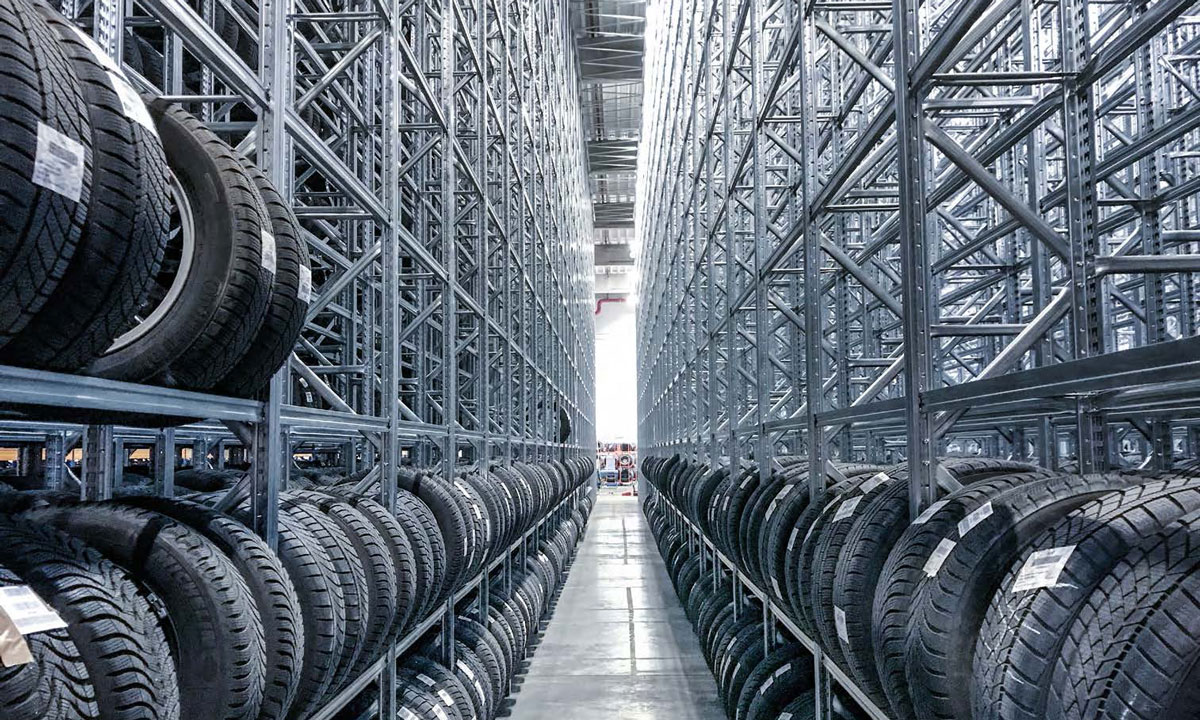Tire storage can be a lucrative business for dealers — especially if it drives more service activity
Tire storage has become such an increasing source of revenue and customer retention that dealers have made it a priority in terms of creating space for it on-site, especially when building or renovating their stores, off-site or utilizing the services of companies that specialize in it.
“Is it a business? I guess it’s kind of like a business now because we charge for it,” said Vaughn Wyant, President/CEO of the Wyant Group, which has stores based in Saskatchewan, Alberta and British Columbia.
“Most people don’t have room to store their tires and snow tires are mandated in (some) provinces, so you get four big tires on wheels and if you live in an apartment you’re out of luck. If you have a garage maybe you can handle them, but they take up a lot of space and most people don’t want to haul them back and forth. They pay for storage and the tires are there and tagged (by software), so it’s pretty good.”
He said in most of his dealerships there is a storage facility on-site, but in Kelowna, where it retails Audi, Porsche and Volvo, there is a plan to build a separate warehouse.
“You end up with so many tires, it’s crazy,” said Wyant. “A lot of dealers have either built a warehouse or when they have renovated their building they changed their plans to add storage. That’s what we did with Jubilee Ford in Saskatoon, which is kind of like the head office, to handle Ford, Mercedes-Benz, Audi, Jaguar, Volvo, Land Rover, Porsche and Mitsubishi.”
He added though the cost of storage might be only $120 per season, there is the possibility of ancillary revenue from doing some other work when the tires are removed, such as an oil change, brake repair or something else that the customer has been waiting to do or the dealership recommended.
“It does help the service departments,” added Wyant. “We make money selling tires, so they become a big part of the sale of a vehicle. Most people handle (the cost) when they buy the vehicle. All-season tires are usually pretty good for a lot of vehicles, but depending on the season a lot of people will go with more of mud or snow tires.”
Robert Issenman, President/CEO of Leader Auto Resources (LAR), the largest dealer-owned procurement company in North America representing 3,200 of the 4,500 dealers across Canada and partnering with more than 10 car manufacturers, said there is big demand for tire storage in Quebec.
LAR’s head office and one of its distribution centres is in Montreal (there are also centres in Calgary and St. John’s) and Issenman said Quebec’s legislation introduced more than 15 years ago transformed the market.
“Before the law, everybody just used all-season tires,” said Issenman. “There was no reason to buy winter tires, but once it became mandatory suddenly every driver had two sets. That instantly created a huge storage problem.”
He added what could have been a headache turned into an opportunity for LAR. Using smarter algorithms to turn its inventory faster, LAR freed up a significant amount of space in its Montreal distribution centre now dedicated to tire storage.
“We saw real value in it,” said Issenman. “It brought us closer to our dealer customers and created a continuous working relationship.”
He said seeing the customer twice a year for tire changes opens the door for dealerships to recommend other maintenance.
“When dealers remove tires, they can check tread wear and the condition of the rims, log the data and let customers know in advance if replacements will be needed,” said Issenman.
“It’s a win for the customer because there are no surprises. You’re not putting on a tire that’s no good. If it’s done right and the wheel keeps turning — pun intended — it works for everyone.”
Some companies, such as Tire Storage Solutions and The Tire Hotel, provide offsite storage facilities for dealers. Convenient Storage Services Ltd. in Courtice in the Durham Region is another company that provides that service, and its slogan is We Save Your Space.
Owner Mike Heffering said he does business with about 20 dealers collectively in Durham and the Greater Toronto Area. The tires are given a specific location once stored in racks in a secure facility and entered on to the website for dealers to access and request when needed.
Heffering agreed the growing need for consumers to store winter tires has provided a cost benefit to dealers in terms of retention.
“The dealers already have the tires and the customers have to come back,” he said. “You’re going to have their car up on the hoist. You’re looking at the brakes, the underside, the fluids, and more likely you’re going to do an oil change twice a year. It just gives such an upside for a sale that an advertisement doesn’t create.”
Heffering started his business 15 years ago, seeing a need for tire storage. He had a background in car dealerships, following his father, Jim, who worked in fixed operations for more than 30 years. Mike was working as a service advisor when he left to create his business.
“I had a good teacher in my father,” said Heffering. “Being at the dealer meetings across the country, you could see what’s going on, so there was an opportunity for me to take a risk and try it out and I just went with it. It’s a pretty simple business that’s grown, and it’s a need for all shops and all dealerships to help them with keeping their customers, which is the hardest part.
“Our success is based on the success of our dealers. We stay focused on providing the best possible service to ensure our dealers’ customers have a seamless experience. The dealers understood a need for it and an opportunity to increase revenue, so over time it just kind of grew and kept going through word of mouth and the service we provide,” he said.
Heffering said the decision by the Government of Ontario in 2015 legislating insurance companies to give a discount on policies for drivers who use winter tires provided dealers with another business opportunity.
“Dealerships try to inform their customers of any kind of deal they can get or a way to save money,” said Heffering. “An insurance discount just helps with the sale. You’re going to save $300-$400 a year on snow tires. It’s a good thing to have, plus the safety side of things. I do think it helps dealerships with increasing their storage and sales for the winter. It increases their overall numbers.”
Some dealers, whether they have space on their lot or want to use an offsite location for tire storage, use the services of Shelving Mate in Richmond Hill that provides innovative and cost effective tire racks for storage.
Their system is rust resistant, has dedicated oval tire beams to prevent tire damage and are much cheaper than the pallet racking typically used for this purpose. The company has been in Canada since 2003 and has worked with all the major car dealerships, auto shops and tire storage facilities across the country.
“Small dealerships typically get 40-foot containers for tire storage and store them in their parking lot,” said Founder/President Jonathan Tebeka.
“They usually have about 10 or so containers and sit the tires inside. Some with more space have dedicated tire racks inside that they try to optimize to the max. Even in a container you have to store the tires properly, nice and organized, so when you have to retrieve them it’s easy to do. Obviously tires are very heavy, especially when stored on rims, so having them on the shelf is obviously more ergonomic, more organized and in most cases you’re actually able to sit more tires per square foot when using proper racks as opposed to just piling them on the floor.”
As more EVs hit the roads, dealers can expect to sell even more tires since the heavier weights of the vehicles, and the instant torque they generate can lead to faster tire wear.


















